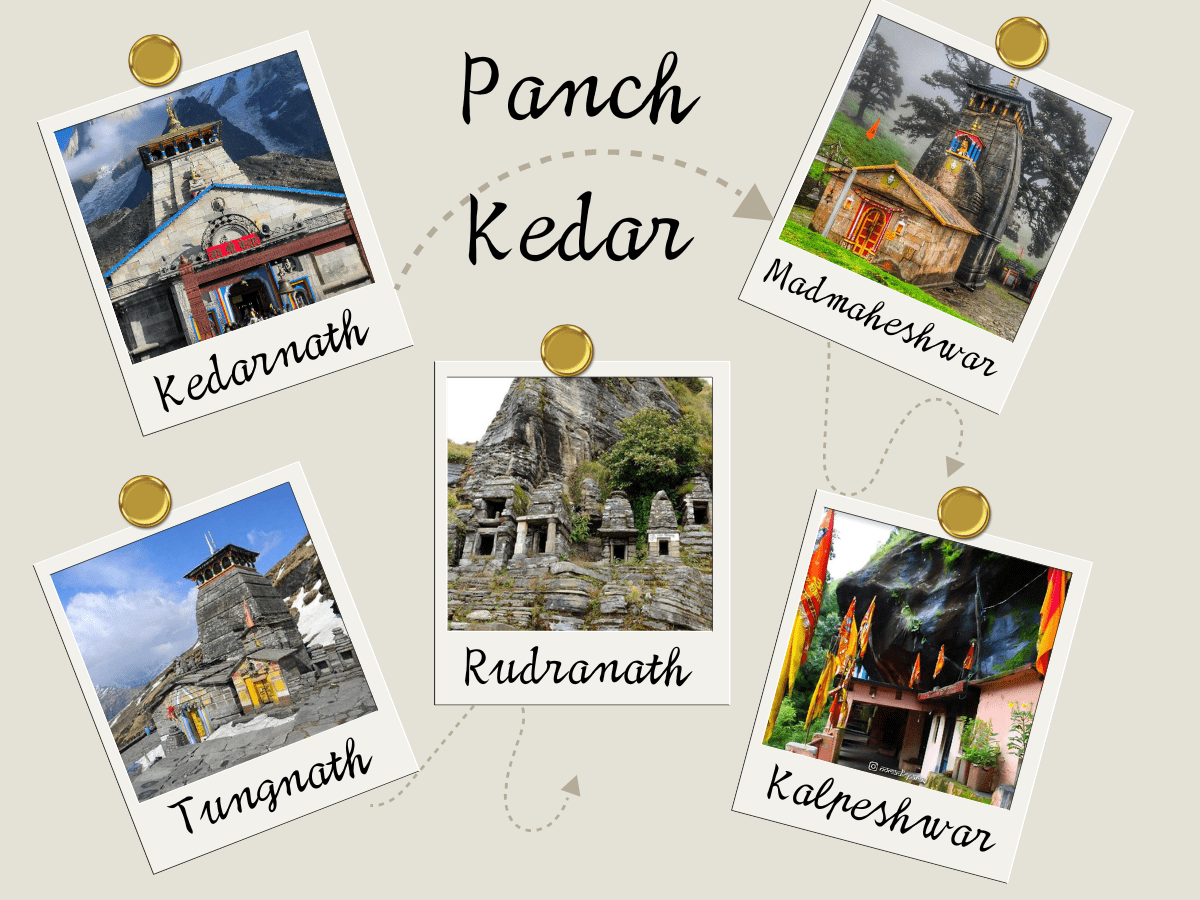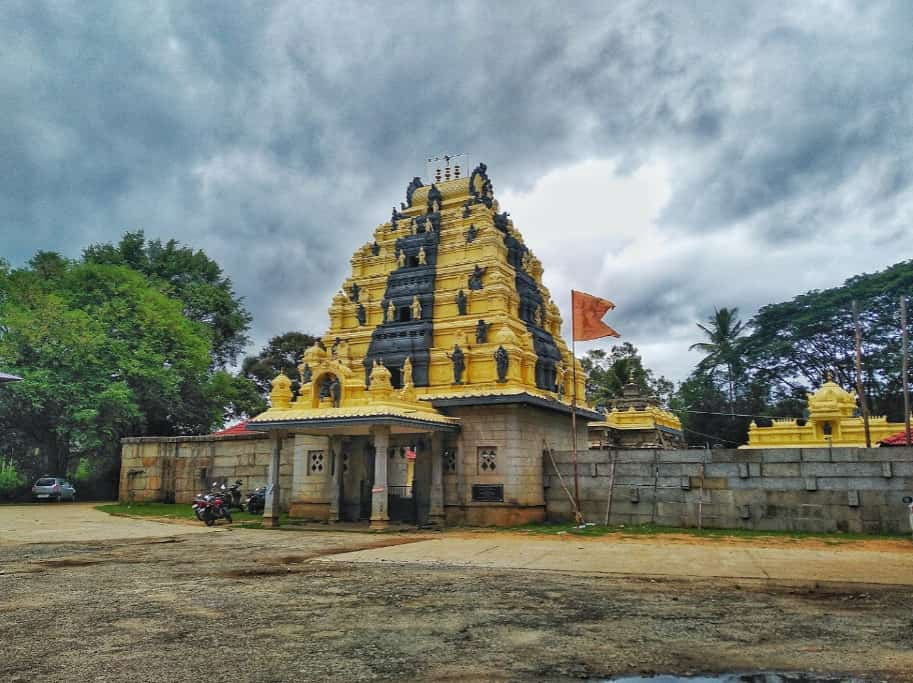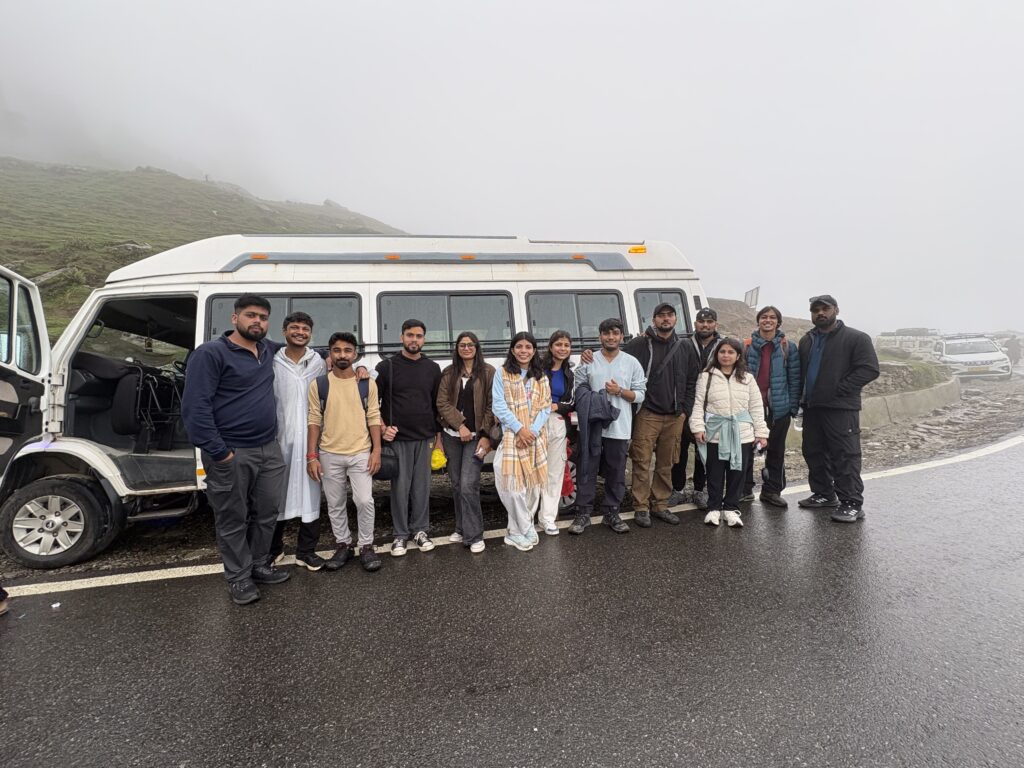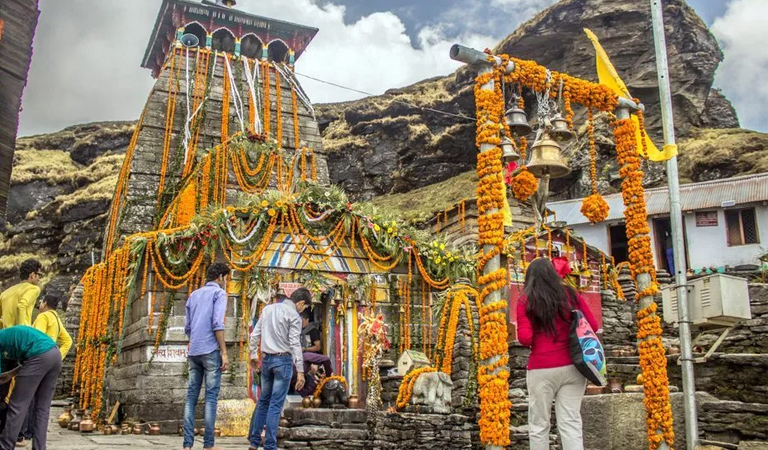Chopta Temples
Published on September 12, 2025
Chopta is a beautiful and peaceful destination in Uttarakhand, known for its ancient temples and stunning natural surroundings. It serves as a popular base for trekking and spiritual journeys in the Garhwal Himalayas. The temples here hold great religious and cultural importance, attracting pilgrims and trekkers alike who come to seek blessings and experience the serene mountain environment.
One of the most famous routes here is the Chopta Chandrashila Trek, which combines adventure with spirituality. This trek starts from Chopta and leads to the Tungnath Temple, the highest Shiva temple in the world, followed by a climb to the Chandrashila peak. These sacred spots not only offer spiritual fulfillment but also breathtaking views of the Himalayas.
The temples in this region are deeply connected to Hindu mythology, especially the worship of Lord Shiva. The blend of spiritual rituals and natural beauty makes Chopta a unique place for those looking to explore faith amidst nature. Visiting these temples during the trek offers a peaceful retreat to connect with tradition and divine energy while enjoying the tranquil environment and majestic mountains. Whether it is trekking or offering prayers, Chopta’s temples hold a special place in the hearts of devotees and nature enthusiasts alike.
This combination of spirituality, culture, and adventure on the Chopta Chandrashila Trek makes it a must-visit destination for travelers seeking both physical and spiritual renewal.

Tungnath Temple Trek – The Highest Shiva Temple
Tungnath Temple is the highest Shiva temple in the world, located in the Garhwal Himalayas of Uttarakhand, India. Perched at an altitude of 3,680 meters (12,073 feet) above sea level, this temple holds immense spiritual and mythological significance. It is part of the sacred Panch Kedar trek and is the third temple in the pecking order of the Panch Kedar pilgrimage. The temple is dedicated to Lord Shiva and is believed to be over 1,000 years old.
Located near Chopta village, Tungnath is accessible through the popular Chopta Tungnath Trek, which is known for its breathtaking views and peaceful natural surroundings. The trek covers approximately 3.5 kilometers from Chopta to the temple, with a moderate gradient suitable for both beginners and experienced trekkers. Many travelers embark on the Chopta Tungnath trek from Delhi as part of spiritual and adventure tours.
Key Highlights of Tungnath Temple:
-
Altitude: 3,680 meters (12,073 feet), making it the highest Shiva temple globally.
-
Mythological Significance: Connected to the Pandavas from the Mahabharata, who sought Lord Shiva’s blessings after the Kurukshetra war.
-
Architectural Style: Traditional North Indian Himalayan temple architecture with stone construction and intricate carvings.
-
Spiritual Importance: It is a vital part of the Panch Kedar temples, visited by thousands of pilgrims annually.
-
Trek Details: The temple trek from Chopta is about 3.5 km, featuring scenic views of alpine meadows, dense forests, and the peaks of the Himalayas.
-
Accessibility: The Chopta Tungnath trek from Delhi is a common route for pilgrims and adventure lovers, offering a blend of spirituality and nature.
Tungnath Temple is not only a place of worship but also a gateway to the Chandrashila peak, making the Chopta Tungnath trek a unique experience that combines devotion, trekking, and breathtaking landscapes. The temple's serene location amidst towering peaks adds to its spiritual aura and attracts trekkers and devotees all year round.
This temple is an essential destination for anyone interested in exploring the deep religious traditions of Uttarakhand while enjoying one of the most scenic treks in the Himalayas.
Spiritual Importance of the Panch Kedar Circuit
The Panch Kedar circuit is a revered pilgrimage route in the Garhwal Himalayas, consisting of five ancient temples dedicated to Lord Shiva. Among these, Tungnath holds a special place as the highest Shiva temple in the world, forming a key part of the spiritual journey for devotees and trekkers alike.
According to Hindu mythology, after the Kurukshetra war, the Pandavas sought Lord Shiva to atone for the sins incurred during the battle. Shiva, angered, took the form of a bull and hid in the Garhwal region. The bull’s different body parts appeared at five locations, where temples now stand, collectively called the Panch Kedar. Tungnath is believed to be where Shiva’s arms appeared, making it spiritually significant.
The cultural and religious significance of this pilgrimage route lies in the devotees’ journey toward purification and forgiveness. Each temple represents a different form of Shiva and offers unique spiritual blessings. After visiting all five temples, pilgrims traditionally extend their journey to the Vishnu shrine at Badrinath, completing the circuit.
Key Spiritual Aspects of Panch Kedar Circuit:
-
The temples symbolize the fragmented form of Lord Shiva’s body and provide blessings for atonement.
-
It connects trekkers with ancient Hindu epics and deep-rooted mythology.
-
The pilgrimage is believed to cleanse sins and grant moksha (liberation).
-
Tungnath serves as a major highlight on the tungnath chandrashila trek from Delhi, blending trekking with devotion.
-
The route offers a mix of serene nature, challenging trails, and spiritual ambiance.
The tungnath chandrashila trek from Delhi offers a unique opportunity to experience this cultural-religious pilgrimage by combining trekking adventure with immersive spiritual exploration, making it a sought-after route for pilgrims and trekkers from across India and abroad.

Ukhimath: The Winter Abode of Kedarnath
Ukhimath is a town that radiates calmness and devotion. Known as the Winter Abode of Kedarnath, this sacred place becomes the home of Lord Shiva when heavy snowfall closes the route to Kedarnath Temple. During these months, the idol of Lord Kedarnath is shifted to Ukhimath, and pilgrims gather here to seek blessings in a peaceful and snow-kissed environment.
But Ukhimath is not only about faith—it is also a gateway to some of the most loved Himalayan adventures. From here, travelers begin their journey towards Chopta, where treks like the Tungnath Temple trail and the Chandrashila Summit climb await. The charm of Ukhimath lies in this unique blend of spirituality and adventure: one moment you are bowing your head in an ancient temple, and the next, you are walking through pine forests on your way to the high Himalayan meadows.
Trek Difficulty Level: Ukhimath to Chopta, Tungnath & Chandrashila
The treks connected to Ukhimath are beginner-friendly yet offer enough adventure to keep the spirit alive.
-
Ukhimath to Chopta (by road): This is not a trekking path but a scenic drive that prepares you for the journey ahead. The winding Himalayan roads are comfortable for most travelers.
-
Tungnath Temple Trek (3.5–4 km): Starting from Chopta, this trail is easy to moderate. Gentle ascents through meadows and forests make it suitable for families, first-timers, and even pilgrims.
-
Chandrashila Summit Trek (1.5 km above Tungnath): This stretch is moderate in difficulty, with a steep climb that requires stamina, especially in snow. Summer makes it easier, but winter adds a layer of challenge and thrill.
Overall, the Ukhimath–Chopta–Tungnath–Chandrashila route is approachable for beginners, rewarding for experienced trekkers, and unforgettable for anyone who takes it.

Other Notable Temples Near Chopta
Chopta is not only renowned for the sacred Tungnath Temple but is also surrounded by several other spiritually significant temples that add depth to the Himalayan experience. These lesser-known shrines carry a quiet charm, and many Chopta Tour Package itineraries now include them to offer travelers a more complete spiritual and cultural journey. Whether you're visiting for devotion, nature, or the thrill of the Chopta Chandrashila trek, these temples make the route even more meaningful.
Sri Markandeshwar Temple (Makku Village)
Located in Makku village, around 28 km from Chopta, Sri Markandeshwar Temple—also known as Markateshwar Temple—holds great importance in the local pilgrimage circuit.
-
This temple becomes the winter seat of Tungnath, as the deity is moved here when the Tungnath Temple shuts down due to heavy snowfall.
-
Dedicated to Lord Shiva, the temple gives devotees an alternative place for darshan, especially for those who cannot attempt the high-altitude trek in winter.
-
Makku village itself is serene, dotted with dense forests and known for incredible birdwatching opportunities.
-
The temple’s architecture reflects the rustic beauty of Himalayan stone craftsmanship, surrounded by silence and towering mountains.
For travelers exploring the region through a Chopta tour package, this temple adds a peaceful and culturally rich stop to the journey.
Omkar Ratneshwar Mahadev Temple (Near Deoria Tal)
Located near Deoria Tal, this Shiva temple is another tranquil place of worship that blends beautifully with nature.
-
Its calm surroundings make it ideal for meditation and quiet reflection.
-
Trekkers often visit this temple while exploring trails connecting Sari village, Deoria Tal, and Chopta.
-
The temple holds deep local significance and offers a serene atmosphere that contrasts beautifully with the adventurous vibe of the Chopta Chandrashila trek.
It’s a spiritual gem hidden amidst dense forests and scenic viewpoints, making it a memorable stop for trekkers and pilgrims alike.
Unique Features and Religious Importance
These temples represent the heritage, architecture, and prayers of Himalayan communities.
-
They complement the Panch Kedar pilgrimage philosophy and give travelers a glimpse of regional customs and seasonal worship practices.
-
For travelers opting for a Chopta tour package, visiting these sites adds both spiritual depth and cultural variety to the journey.
Including these temples in your itinerary enriches the entire Chopta experience—allowing you to blend devotion, nature, and adventure as you explore the sacred landscapes surrounding Chopta and the legendary trail of the Chopta Chandrashila trek.

Temples on the Chopta Tungnath Trek and Chandrashila Trek
The Chopta Tungnath trek and Chandrashila summit trek attract thousands of trekkers every year—some come for the thrill of the mountains, while others seek the deep spiritual energy that flows through these ancient Himalayan trails. When you choose the Tungnath Chandrashila Trek from Delhi, these temples become the heart of the journey, offering a blend of mythology, nature, and peaceful Himalayan devotion.
Starting from the scenic meadows of Chopta, the trail leads straight to the legendary Tungnath Temple—the highest Shiva temple in the world. Sitting majestically at 3,680 meters, Tungnath is the third temple in the revered Panch Kedar circuit. According to mythology, the Pandavas built this sacred shrine to seek forgiveness from Lord Shiva after the events of the Kurukshetra war. The stone-carved temple stands gracefully amidst towering peaks, creating a setting where spirituality merges seamlessly with nature.
From Tungnath, the path continues upward toward Chandrashila Peak, a highlight for anyone attempting the Chandrashila part of the journey. This final ascent is the soul of the Tungnath Chandrashila Trek from Delhi, where trekkers cover about 1.5 kilometers on a steep and rocky trail. Chandrashila, meaning “Moon Rock,” carries its own powerful legend—it is believed to be the very place where Lord Rama meditated after defeating Ravana.
The climb may be short, but it rewards you with unforgettable Himalayan views. From the summit, you can see iconic peaks like Nanda Devi, Chaukhamba, Trishul, and Kedarnath Dome glowing against the sky. It’s one of the most breathtaking panoramas in Uttarakhand—an experience that blends adventure, divinity, and raw mountain beauty.
Other Temples Along the Trek:
-
Lord Kartik Swami Temple: Located in the small village of Kanakchauri, this temple dedicated to Lord Kartikeya is about 3 km from Chopta and features steep stairs to reach the shrine. It is known for its colorful celebrations during the festival season.
Significance in Trekking and Pilgrimage:
-
The chopta tungnath trek package often includes visits to these temples, allowing trekkers to experience spirituality alongside adventure.
-
The temples represent a physical and spiritual journey where trekking challenges meet divine blessings.
-
They connect the trekker to deep-rooted Hindu myths and local beliefs, making the trek a pilgrimage as much as an adventure route.
-
The blend of temple visits with breathtaking trekking makes this route a unique and fulfilling experience for both devotees and nature lovers.
This combination of religious heritage and natural beauty, found along the Chopta Tungnath trek and the Chandrashila summit trek, makes it a sought-after destination for travelers seeking both spiritual and physical fulfillment. The temples encountered on the route provide not only places for worship but also cultural insights and moments of peaceful reflection amidst the awe-inspiring Himalayan landscapes.

How to Reach and Visit Chopta Temples
Chopta is a peaceful Himalayan destination famous for its ancient temples and stunning trekking routes. Visiting the temples around Chopta involves careful planning to enjoy the spiritual experience along with breathtaking natural beauty.
Access and Transportation
-
The nearest major city is Dehradun, with an airport and railway station well-connected to Delhi and other parts of India.
-
From Delhi, travelers usually take an overnight bus or train to Rishikesh or Haridwar, followed by road travel to Ukhimath or Srinagar in Uttarakhand.
-
From Ukhimath or Srinagar, hire a taxi or use shared vehicles to reach Chopta, which is about 29 kilometers away.
-
Road connectivity to Chopta is well-maintained but narrow; private cars and taxis are common.
-
For ease and comfort, many opt for a Chopta tour package from Delhi, which includes all transportation arrangements.
Trekking Routes
-
The scenic Chopta Tungnath trek from Delhi starts at Chopta and covers 3.5 km to Tungnath Temple. The trek is accessible and popular among beginners and experienced trekkers.
-
From Tungnath, you can continue the Chandrashila trek, which climbs to Chandrashila Peak, offering panoramic views of the Himalayan range.
-
Package tours combining these treks such as the Chopta Chandrashila trek from Delhi and Chandrashila trek from Delhi ensure well-organized guidance, stays, and meals.
Best Time to Visit
-
Spring (April to June) and post-monsoon (September to November) are ideal for trekking and temple visits. Weather is clear and comfortable.
-
Winters (December to March) bring heavy snowfall, closing many temples, including Tungnath, and making trekking difficult.
Tips for Pilgrims and Tourists
-
Carry warm clothing as temperatures can drop significantly.
-
Wear sturdy trekking shoes for rough mountain paths.
-
Respect local customs, especially in temple areas.
-
Acclimate gradually to the altitude for a comfortable visit.
-
Pre-book through a Chopta tour package for hassle-free transit, accommodation, and trek arrangements.
By planning well and choosing packages like the Chopta Tungnath trek from Delhi or Chopta Chandrashila trek from Delhi, travelers can experience the spiritual and natural wonders of Chopta smoothly, combining adventure with cultural richness.

Festivals and Rituals at Chopta Temples
Chopta’s sacred temples—including the revered Tungnath shrine and other nearby holy sites—are not just architectural landmarks but living centers of devotion, festivals, and ancient rituals. These celebrations reflect the spiritual heart of Uttarakhand, giving travelers a deeper connection to the region’s heritage. When you plan a Chopta Chandrashila trek from Delhi, experiencing these rituals adds a meaningful cultural layer to your adventure.
One of the most significant festivals celebrated in this region is Mahashivratri, dedicated entirely to Lord Shiva. Devotees observe fasts, perform rituals, chant powerful hymns, and participate in night-long prayers that fill the mountains with divine energy. Celebrated in February or March, Mahashivratri draws thousands of pilgrims to Tungnath Temple and the surrounding shrines, creating a spiritual atmosphere that beautifully complements the serenity of the Himalayas.
Another major event is the Opening and Closing Ceremonies of Tungnath Temple. Because Tungnath receives heavy snowfall in winter, the doors of the temple are closed during the cold months. Around late April or early May, the shrine reopens with great devotion and traditional rituals. The highlight of this ceremony is the revered Utsav Doli, a grand palanquin procession that carries the deity’s idol from its winter seat in Makku village back to Tungnath. This marks the official start of the pilgrimage season and is a deeply emotional moment for locals and travelers alike.
For anyone undertaking the Chopta Chandrashila Trek from Delhi, witnessing these festivals adds unmatched value—combining adventure, culture, and spirituality into one unforgettable Himalayan experience.
Major Festivals and Rituals:
-
Mahashivratri: Night-long worship of Lord Shiva with prayers, fasting, and rituals.
-
Temple Opening Ceremony: Welcoming the deity back to the mountain temple with traditional processions and special aartis.
-
Dussehra and Diwali: Celebrated with local fairs and vibrant festivities in nearby villages.
-
Paandav Leela: A unique cultural festival involving the enactment of the Mahabharata, reflecting the region’s mythological ties.
Best Seasons to Visit:
-
Spring (April to June): Ideal for visiting temples as pilgrimage season starts with the reopening of temples like Tungnath.
-
Post-monsoon (September to November): Crisp weather and clear skies make it perfect for trekking and festivals.
-
Avoid winter months (December to March): Most high-altitude temples close due to heavy snow, including Tungnath.
Visiting Chopta during these festival seasons through a Chopta tour package provides not only spiritual upliftment but also a chance to witness age-old traditions, folk music, and dance performances. The blend of breathtaking natural beauty with vibrant religious customs creates a memorable and enriching experience for every visitor.
These rich traditions along with the unique Himalayan setting make Chopta temples a lively and inspiring destination beyond just trekking and sightseeing.

Combining Spirituality and Adventure in Chopta
Chopta is a unique destination where spirituality meets adventure amidst the stunning backdrop of the Himalayas. This peaceful hamlet is known as the base for some of Uttarakhand’s most famous treks, including the renowned chandrashila trek from delhi. Visitors to Chopta often experience a harmonious blend of trekking, spiritual visits to ancient temples, nature exploration, and camping under the stars, making it a perfect escape for both soul-searchers and adventure lovers.
The treks leading to the spiritual temples of Tungnath and onward to Chandrashila offer not only physical challenges but also moments of deep reflection and peace. Tungnath Temple, the highest Shiva temple, provides a divine setting where pilgrims connect with centuries-old Hindu traditions while being surrounded by breathtaking mountain vistas. Continuing the trek to Chandrashila peak rewards trekkers with panoramic views and a sense of accomplishment, reinforcing the bond between nature, spirituality, and human endurance.
Key Experiences in Chopta:
-
Trekking Adventures
Gentle trails from Chopta to Tungnath and the more challenging ascent to Chandrashila create a memorable journey filled with alpine meadows, rhododendron forests, and pristine air. -
Spiritual Visits
Temples like Tungnath serve as spiritual hubs where travelers observe traditional rituals and find tranquility away from city life. -
Camping in Nature
Camping in Chopta intensifies the adventurous spirit as trekkers spend nights beneath clear, star-studded skies, surrounded by peaceful wilderness. -
Wildlife and Bird Watching
The dense forests around Chopta are home to diverse flora and fauna, making it a paradise for nature enthusiasts and bird watchers. -
Yoga and Meditation
Many visitors use this serene environment for yoga and meditation, finding mental calm and rejuvenation without disturbances.
The Chopta Chandrashila Trek is especially popular among weekend adventurers and spiritual seekers traveling from metropolitan areas. Tour packages typically include guided treks, accommodation, meals, and transport, allowing travelers to focus on absorbing the natural and spiritual richness of the region.
Combining spirituality and adventure in Chopta creates an unforgettable journey that nourishes both body and soul. Whether it’s chanting prayers at an ancient temple, breathing fresh mountain air on a trek, or camping under a vast Himalayan sky, Chopta offers a holistic experience for anyone seeking connection, peace, and exploration.
Frequently Asked Questions:
1. Why is Chopta famous for?
Chopta is known for several trekking routes that run through it and around it. One of the most popular routes is to the Chandrashila peak, a trek of around 9 km. En route falls the sacred Tungnath temple, the highest Shiva shrine in the world. This trek is best enjoyed between December and January.
2. Is it safe to visit Chopta now?
It is absolutely safe to travel to Chopta. But beware, the wildlife dwelling in Chopta region isn't this much friendly and tourists are advised not to roam around in the Jungle after the sunset!
3. Is alcohol allowed in Chopta?
Tourist carrying alcohol on Chopta-Tungnath trek fined and prohibited from proceeding further. 2. Strict legal action will be taken against anyone found engaging in undesirable activities on the Chopta-Tungnath trek
4. Does it snowfall in Chopta?
Chopta is also a popular destination during the winter months due to the snowfall that the area experiences. Tungnath temple and Chandrashila are covered with snow from December to March.
5. Can we go Chopta by car?
Although direct buses to Chopta are unavailable, buses to Ukhimath, Guptkashi, or Gopeshwar can be taken, and from there, shared jeeps or taxis are available to reach Chopta. By Road: Chopta is well-connected by motorable roads, making a taxi or personal vehicle the most convenient way to reach the region.
6. What clothes should I pack for Chopta?
Pack Accordingly:
Winter in Chopta can be harsh, with temperatures plummeting. Pack layers, including thermal wear, insulated jackets, gloves, and sturdy waterproof boots. Don't forget essentials like a hat and sunglasses to protect against the winter sun's glare.
7. Is Chopta Trek difficult?
Chopta Chandrashila trek falls under easy category. The trek difficulty dictates your level of fitness and preparations for it. As mentioned above, it is easy level trek but preparation is needed as it's mountainous terrain.
8. How to go Chopta from Delhi?
There is no direct connection from New Delhi to Chopta. However, you can take the bus to Samas Pur Jagir, take the bus to Haridwar, then take the taxi to Chopta. Alternatively, you can take the train to Kotdwara then take the taxi to Chopta.
9. Which time is best for Chopta?
The best time to do Chopta Chandrashila Trek is from early summer to post monsoon time. April to June: This time trails look beautiful as the arrival of spring makes flowers alive and vibrant. Blooming rhododendrons and clear view of Himalayan peaks make it an ideal time to do Chopta Chandrashila Trek.
10. Is there snowfall in Tungnath today?
Today's weather of Tungnath is expected to be Patchy rain nearby with a maximum temperature of 11° C and a minimum temperature of 1° C.


